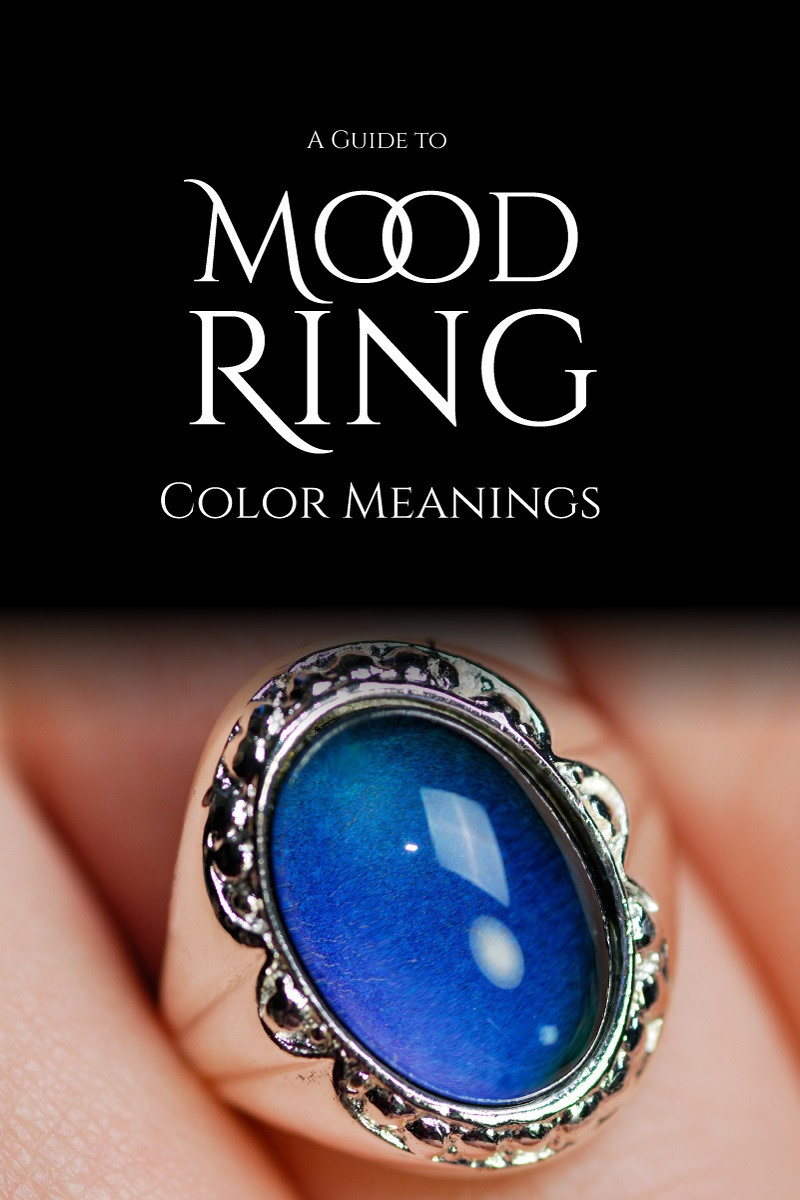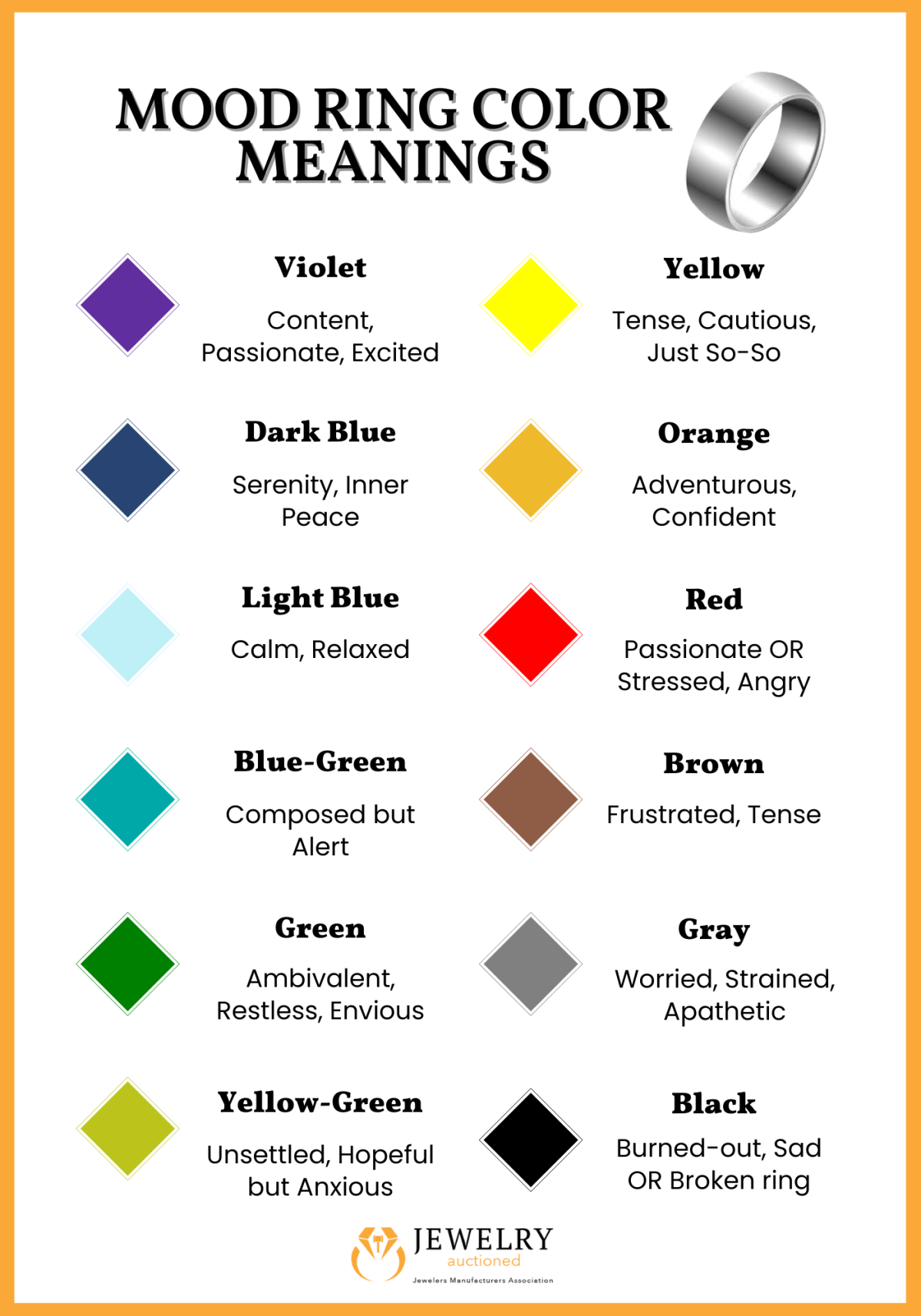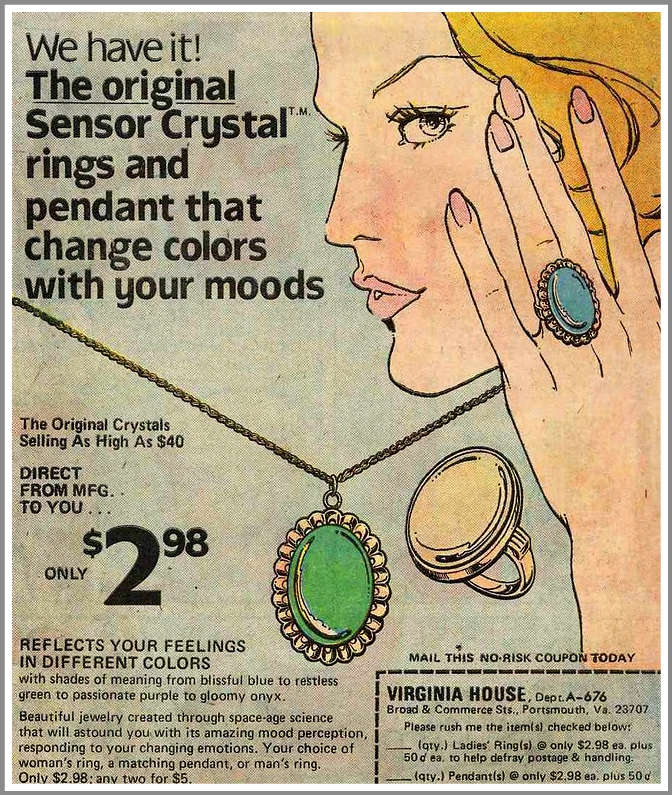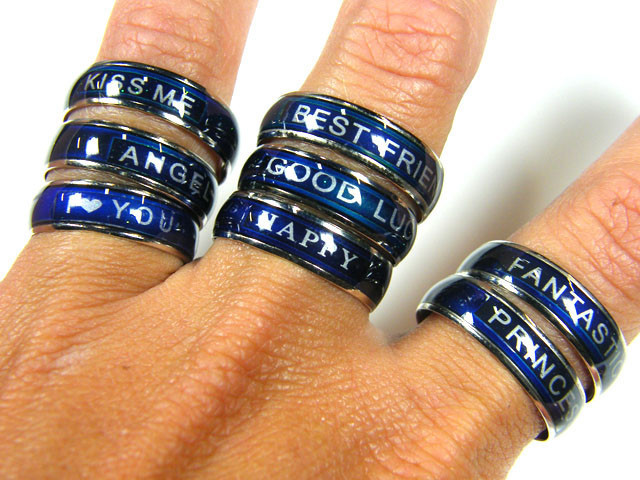
Full Mood Ring Guide: Color Meanings, Chart & History
 Mood rings are a trendy temperature-sensitive, color-changing ring marketed to change color according to your current mood when worn. Their invention in the 1970s reflected the greater cultural focus on spirituality and self-reflection, particularly in America.
Mood rings are a trendy temperature-sensitive, color-changing ring marketed to change color according to your current mood when worn. Their invention in the 1970s reflected the greater cultural focus on spirituality and self-reflection, particularly in America.
Color-changing mood rings have been around for nearly 50 years, with spikes in popularity at their release in the 1970s and during the 1990s. Other names include “Multi-Color Mood Ring” and “Sensor Crystal™ ring.”
But are mood rings still a thing? Yep, you can still find mood rings for sale. They may not be as talked-about or widely popular as they once were, but mood rings have been a mainstay for many young girls over the years.
Today, we’ll go over just how mood rings became so popular, the science behind how they work, and what every mood ring color means.

How Do Mood Rings Work?
In a nutshell, mood rings are indicators of temperature changes. The “stone” inside is actually a liquid crystal gel that’s thermotropic, so it changes color when the temperature changes. Technically, the temperature shifts cause the liquid crystal to move around, which changes the color they reflect.
Every mood ring manufacturer uses slightly different formulas, materials, and techniques. Most times, the neutral base color is adjusted to correspond to a standard baseline body temperature.
The majority of mood rings have liquid crystals derived from organic polymers. The mixture is then encased in glass or quartz. In its simplest form, a mood ring has a metal ring base with a thermochromic liquid crystal strip glued on top, encased in a protective layer of glass or plastic like a cabochon.
You know the scientific side, now it’s time for the ~magical~ side. What do the colors in a mood ring mean?
Mood Ring Color Meanings List
The original mood rings had 6 to 7 colors, listed from least positive to most positive emotions: black, gray, yellow, green, blue, and violet, sometimes with a seventh color like reddish-brown or another shade of blue.
Of course, science always advances. Today, there are mood rings with all sorts of colors and associated emotions. Below, we’ll go over what the colors in a mood ring mean, along with a chart for easy reference.
Violet or Violet-Blue
Since the inception of mood rings, violet or violet-blue has been considered the best color, reflecting an emotional state of contentment, passion, and excitement. One 1970s commercial for the Multi-Color Mood Ring states, “the most desired shade of violet-blue.”
Other violet or purple mood ring color meaning interpretations are that you’re feeling sentimental, intimate, or in-love.
Dark Blue
The dark blue mood ring color meaning is one of deep calm and complete serenity. When you see your mood ring is dark blue, it’s an indicator of true inner peace and mindfulness.
Light Blue
Like dark blue, a light blue mood ring color means you’re feeling calm and relaxed, just maybe not as deeply as dark blue indicates. Most mood rings have a blue baseline color, showing your body being at a standard temperature.
Blue-Green
Shifting away from total calm, a blue-green mood ring color means that you’re fairly relaxed but also alert. This alertness may be because of subconscious anxieties that aren’t at the forefront of your mind. After all, mood rings were originally marketed as revealing your truest, hidden or subconscious emotions.
A blue-green mood ring may also simply signify that you’re calm but also somewhat active. Perhaps you’re relaxed while doing some fun internet research that keeps you intrigued.
Green
When your mood ring is green, it can signify ambivalence or restlessness. Maybe you’re feeling uncertain about an upcoming situation. Of course, you may also be feeling green with envy, though it’s probably not taking over your life.
We should note that many mood rings have a green baseline, rather than blue, so the green color would indicate a neutral calm.
Yellow-Green
A yellow-green mood ring color means you’re experiencing mixed emotions and feeling unsettled. This color may come up when you’re thinking of a crush you have and feeling hopeful yet anxious.
You may be more sensitive than usual, becoming irritated or dejected more easily. Overall though, you’re still relatively collected.
Yellow
Yellow is where we start getting into the spicier mood ring color meanings, though not always in a great way. A yellow mood ring color suggests you’re feeling tense and cautious.
You probably have lots of thoughts flying through your head, but you can’t nail down the rhyme or reason. On the nicer side, you may just feel so-so. On the more negative side, you may feel a sense of foreboding.
All that said, some interpret yellow mood ring colors as imaginative, observant, and creative.
Amber or Orange
Orange or amber mood ring colors suggest you’re craving excitement and adventure. This mood ring color is all about new beginnings, along with confidence and affection.
If you’re out feeling cute and confident while doing something adventurous with your boo, expect an amber mood ring color.
Red
Interpretations of red mood ring color meanings go two ways.
On one hand, red mood ring colors can reflect passion, thrill, and arousal, like a sensual red dress on date night. On the other hand, red mood rings can signal that you’re feeling super stressed, alarmed, or angry.
In general, the former interpretation applies to deeper reds while the latter interpretation applies to bright reds.
Brown
If your mood ring is brown, this signifies feelings of frustration, restlessness, and tension. You may be feeling fearful or irritated about something and unable to shake it from your mind.
Brown mood ring colors often appear in times of nervous anticipation or aggravation.
Gray
Similar to brown, a gray mood ring color means you’re feeling worried or strained. Gray indicates more disillusionment, though, with feelings of apathy, pessimism, and aloofness.
Black
The black mood ring color meaning is arguably the worst, indicating burn-out, stress, and inhibition. Some interpret black mood ring colors as mystery or intensity, but most interpret black as being down in the dumps. Black usually appears at the coldest temperatures.
Now, a black mood ring may also be dysfunctional. Mood rings that broke, due to extremely high temperatures or moisture, will turn black.
Here's a handy mood ring color meanings chart for quick reference:

History of Mood Rings
Mood rings began as a 1970s craze. Most sources credit two New Yorkers for the invention: Joshua Reynolds and Maris Ambats.
Reynolds was a mid-30s Wall Street marketing exec but gained an interest in biofeedback, reportedly leading him to the idea for mood rings.
However, others credit the invention to California jeweler Marvin Wernick, who allegedly came up with the idea after seeing a doctor measure a child’s temperature with thermotropic tape.
Regardless, mood rings hit the market in August 1975 and skyrocketed with the help of department store Bonwit Teller, who marketed them as “truth rings.”
 Pictured above: Vintage 1970s mood ring advertisement
Pictured above: Vintage 1970s mood ring advertisement
The first three months saw 40 million rings sold, appearing on the hand of Barbara Streisand and even as the subject of a poem by Muhammad Ali. The first year capped with Reynolds making at least $20 million from mood ring sales.
Though most at the time were cheap and not long-lasting, the mood ring’s exponential popularity led jewelers to create higher-quality versions in metals like gold and sterling silver.
The popularity of mood rings reflected many fundamental aspects of 1970s culture, particularly in America.
American author Tom Wolfe coined the 70s as the “Me Decade” (just a year after the mood ring’s release), describing many people’s attitude shifts from community-based endeavors to a focus on understanding one’s own self and emotions better.
Unfortunately, the mood ring fad would only last about a year or so. That is, until the 1990s.
 Pictured above: 1970s Vintage Comic Print Ad for Mood Sensor Crystal Rings
Pictured above: 1970s Vintage Comic Print Ad for Mood Sensor Crystal Rings
Resurgence in the 1990s
A decade and a half later in 1991, mood rings were “back,” according to the Chicago Tribune. The resurgence started when two women saw interest in their “vintage” mood rings and started their own company. Similarly to the first wave, the women sold 100,000 rings in their first three months.
Taking advantage of the phenomenon, the short-lived clothing company Hypercolor started selling color-changing clothes. The trend extended into mood collars for pets in 2004, an LED “Mood Sweater” in 2014, and various mood nail polishes.
Mood Ring Changes and Improvements
Since the original mood ring’s invention, the composition has improved over time.
The first mood rings would stop functioning if any water reached the liquid crystal inside. Modern versions keep the liquid crystal sealed better to prevent moisture from getting inside.
In fact, the originally credited inventor Josh Reynolds, along with the team of The Mood Science Company, released a new-and-improved version in the last few years: the 2018 Mood Stone. The new line includes mood rings in their original design and a new design, all of which are sterling silver or gold vermeil.
Other companies have stepped up the tech with Bluetooth digital mood rings that measure and reflect colors based on more physical reactions than just temperature.
 Image credit: Moodman001 | Creative Commons Attribution-Share Alike 4.0 International license
Image credit: Moodman001 | Creative Commons Attribution-Share Alike 4.0 International license
Do Mood Rings Work?
The idea of measuring emotional states with body temperature is somewhat based in science. Your endocrine system (mostly known for regulating hormones) can adjust physiological conditions (like temperature, heart rate, and blood flow) for different emotional states.
Your body temperature can increase when you’re feeling love or happiness but decrease with feelings of shame or sadness. In fact, research has shown that certain emotions are felt in specific areas of the body pretty consistently across different cultures.
One factor to remember is the degree of temperature change. Body temperatures don’t change drastically, so mood rings have to be pretty precise in picking up on even the slightest temperature shifts.
All that said, temperature — and thus mood rings — aren’t the sole indicator of your emotional state. Lots of physiological changes are at play.
From a psychological standpoint, however, mood rings can be beneficial for regulating stress and understanding your own emotions better.
In 2018, Josh Reynolds told Stu News Laguna that research from him and his team, which includes a Science and Medical Director, “suggests the self-awareness and stress management features of the ring have a considerably broader appeal range from teens to boomers, today [more] than 40 years ago.”
From that perspective, mood rings can be reminders to check-in with your current emotional state and increase mindfulness, ultimately increasing emotional intelligence and self-awareness.
How Long Do Mood Rings Last?
Most mood rings that have been around since the 1970s probably don’t function now, but improvements have been made for longevity since then.
At the minimum, mood rings will last two years or so, with some making it to five years.
The biggest threat to mood ring function is moisture. A drop of water touching the liquid crystal will make the ring black forever. Avoid wearing mood rings in the shower, ocean, or pool.
Other factors that can damage mood rings are prolonged, direct exposure to extreme heat. Don’t leave your mood rings in a hot car or store them in direct sunlight.
The best place to store mood rings is in a room-temperature area away from direct sunlight and moisture.

In the Mood for a Mood Ring?
Mood rings may have had their heyday in the ‘70s and ‘90s, but they remain a cultural staple, especially among young women.
Some might see mood rings as a tacky novelty item, while others may use them as a reminder to check in on their emotions. Still others can appreciate the way mood rings encapsulate the overarching cultural shift of the 1970s.
Ready to shop? Browse our collection of mood rings!
Search the Fashion Encyclopedia
Related Auctions
Related Articles
How to buy a ruby for your ring or pendant,Make sure that you learn as much as you can about Rubies, prior to buying a ring or a setting that you are going to add Rubies to. Like Diamonds, Rubies can be flawed, and imperfect The Ruby is one of the most b
10th Apr 2019
Jewelry gemstones are always tops in online demand
3rd Jan 2021
Latest Articles
Titanium is a popular jewelry metal known for being lightweight, durable, and affordable. Learn all about titanium, how it compares to similar metals, and the pros and cons of titanium jewelry.
7th Feb 2023
Learn all about tungsten jewelry - from its history and uses to its durability and care. By the end of our guide, you’ll know if tungsten is right for you!
7th Feb 2023
Thinking about adding some timeless white gold jewelry to your fine accessories collection? Here’s all there is to know about sophisticated white gold!
29th Jan 2023








